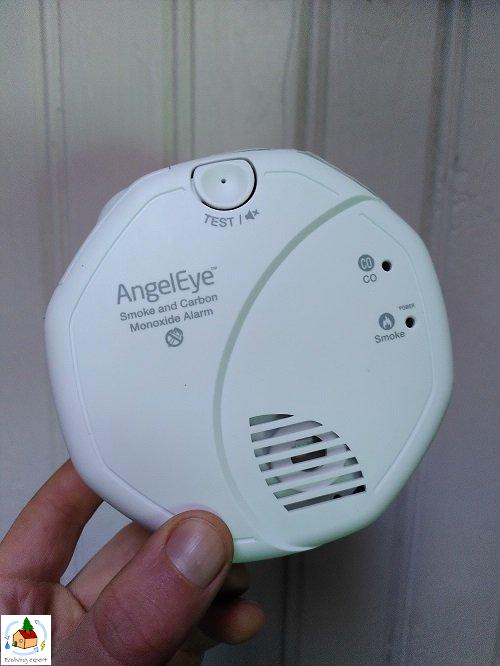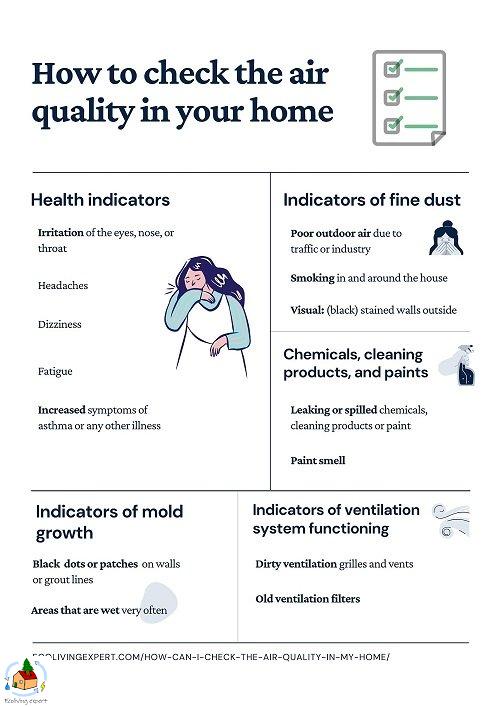Bedroom air quality not only affects your health directly, but it also affects the quality of your sleep and how you feel the next day. Common effects of poor air quality are a feeling of fatigue, dry eyes, and headaches. But, of course, air quality is not always the cause. It is, nonetheless, good to test the air quality so you can take measures when needed.
There are many direct and indirect ways of testing your bedroom’s air quality. These include:
- purchase an air quality monitor
- use an air purifier
- install CO monitors
- conduct a radon test
- check if you have air-quality related health symptoms
- check your ventilation system and its filters
- look for signs of mold
- pay attention to dust build-up
- check if your cleaning products are natural and healthy
- check if your household chemicals and paints are natural and healthy
- consider your carpet or lack of carpet
- contact a professional
As you can see, there are several options that directly test (part of) your indoor air quality. Additionally, there are several indicators to check that can tell you whether the quality of your air is likely to be poor.
An air quality monitor tests the air continuously
Using an air quality monitor is by far the best, most reliable way of testing your bedroom air. It continuously scans the air for harmful particles. Also, a good air quality monitor tells you exactly how bad the air really is and you can take measures such as ventilating based on this information. Nowadays, air quality monitors connect to an app on your phone so you know exactly what you are facing.
An air quality monitor has the advantage over an air purifier in that it tests for more compounds than an air purifier can remove. For example, an air quality monitor informs you about the presence of carbon monoxide and radon. An air purifier does not and cannot remove these compounds from the air.
I found a Norwegian company called Airthings, which produces excellent air quality monitors. They are easy to operate (just wave your hand in front of the device) and send their data to an app on your phone.
Discount on Airthings air quality monitor
By using this link to the Airthings wave Mini air quality monitor, you will get about 10% discount! The Airthings Wave Mini is a small battery-operated device that measures total VOCs, temperature, and humidity levels.
If you are willing to spend a bit more to be absolutely sure about your indoor air quality the Airthings Wave Plus is an excellent option. This air quality monitor not only measures VOCs, humidity, and temperature but also CO2 levels, air pressure, and radon. Just like the Wave Mini, it comes with an app that shows your latest data. By using this link to the Airthings Wave Plus air quality monitor you will get a discount of about 10%!
Using an air purifier
Ventilation is the most easiest and important thing you can do to improve your bedroom air quality. However, an air purifier is a great additional measure. Especially when:
- you have allergies or asthma
- you do not have the option to ventilate constantly
- your ventilation is not adequate and you still have poor air quality despite ventilating
- regularly cleaning opening windows is not sufficient
An air purifier is not a direct way of testing the air in your bedroom for pollutants. However, it does make sure that the air is clean. Therefore, after running the air purifier, you know that the air is clean. (if you want to know how long you need to run your air purifier, you can check my article: How long should you run your air purifier?)
For more in-depth information about air purifiers, I recommend reading my article: How to know if you need an air purifier (+ what it does and doesn’t do)
Install CO monitors
Although most CO monitors only check for carbon monoxide, they are essential in any home. They are especially important close to the bedroom since want to be informed as quickly as possible when CO levels are rising. If you want to know more about carbon monoxide, I recommend reading my article: What levels of air quality are dangerous? (with overview table).

Why you should test for radon
Radon is one of the main causes of lung cancer in the United States. However, it is a naturally occurring gas that is very difficult to detect. It is best to check with local authorities to learn about your local radon levels and if there is anything that can be done if necessary.
Radon is not equally present all over the world. Therefore, some countries need to pay more attention to radon than others. On radonmap.com you can find if you live in an area where you are at risk of radon exposure.
If you want to know more about radon, I recommend reading my article: What is radon? (origin, health risk, and preventive measures)
Check if you have air quality related health symptoms
Poor air quality can result in all kinds of health problems, ranging from minor complaints to serious long-term effects. Therefore, health effects related to poor air quality are an indirect test of the quality of your air. Normally health effects due to bad air quality will be minor such as dry eyes, a little fatigue, or a cough. However, some compounds can have more serious health effects.
Early health symptoms related to poor indoor air quality
The most common symptoms of air pollution are due to short-term exposure to low amounts of pollutants. These symptoms include:
- irritation of the eyes, nose, or throat
- headaches
- dizziness
- fatigue
- increased symptoms of asthma or any other illness
Important factors in experiencing health effects are your overall wellbeing, age, and possible sensitivity to a specific compound. Additionally, increased exposure due to higher concentrations, and longer exposure time increase the potential health effects.
Common health effects from long-term exposure
According to the Environmental Protection Agency (EPA) of the United States. long-term health effects of indoor air pollutants may show up years after exposure or after long or repeated periods of exposure. Possible long-term adverse health effects include:
- respiratory disease
- heart disease
- cancer
These effects may show up years after exposure to hazardous compounds and can be the result of many and any combination of factors. Therefore, it is almost impossible to contribute these health effects to poor indoor air quality.

Children show symptoms earlier
Children are more susceptible to indoor air pollutants because they inhale more air and thus pollutants per kg of body weight than adults. Additionally, children’s airways are narrower than adults, so irritation and swelling of the airways can result in relatively greater airway blockage.
Therefore, look at (your) children and how they are feeling when they are in the bedroom for a long time. If they seem to show health effects that might indicate poor indoor air quality, it might be time to take measures.
Check your ventilation system and its filters
The most important method of preventing poor indoor air quality is your ventilation system. It should be running all the time and has to be in good condition to function properly.
Therefore, a good indication of your indoor air quality is the condition of your ventilation system. You should regularly check, clean, and replace your ventilation filters, vents, and grilles to keep them in good condition.
Make sure to replace your ventilation filters approximately twice a year. This will depend on how quickly they get dirty, and whether you have pets. If you have preexisting respiratory issues, replacing the filters more often is advised.
For more details on the type of filters and when they need to be replaced, I recommend reading my article: True HEPA vs HEPA-type: application, durability, costs, and efficiency.
Next to your ventilation system, opening bedroom windows is another way of allowing air exchange between the indoor and outdoor air. You should ventilate often, opening windows every day and leave them open any time you have the option.
Mold growth indicates poor air quality
The spores of molds are always present in the air in very small quantities. They normally do not pose any health hazards. However, when mold spores land in a spot that is humid and warm, they can start to grow and produce very high quantities of spores. This can lead to various health effects and can damage wood and fixtures.
Where to check for mold growth in the bedroom
Mold growth is more common in places that often become wet, and/or places where food scraps can linger such as the kitchen and bathroom. In the bedroom, the areas to check are:
- window frames
- houseplants (the pots, soil, and nearby walls)
Mold is quite easily recognized by dark (often black or dark green) dots or stains and patches.
There are several ways to prevent mold growth and exposure to its spores.
- regular and thorough cleaning
- continuous ventilation
- installing an air dehumidifier
Unfortunately, an air quality monitor cannot detect mold spores in the air. However, Airthings, a manufacturer of air quality monitors, has created a monitor that can help with detecting molds. It looks for several indicators of potential mold. And if these indicators are present for a long period of time, it lets you know you might have a mold issue.
I wrote an article on air quality monitors and how to use them to detect mold. You can find it here.
Dust build-up is an indication of poor air quality
Dust build-up is another indication of poor air quality. The presence of dust means that there is little ventilation that moves dusty air outside. Additionally, it means that relatively high amounts of airborne particles are present, especially if there is a lot of dust even though you clean regularly.
Simple solutions are to ventilate and clean more often. An air purifier is another excellent way of removing airborne particles such as dust.
Cleaning products, paints, and chemicals can be an air pollutant
Surprisingly, cleaning agents are a source of air pollution. The specific hazardous compounds coming from cleaning agents depend on many factors, including their composition and reactive chemistry. However, the presence and use of chemical cleaning products, as well as other chemicals and paints, indicate that harmful compounds are present in your air.
Just like scent, harmful compounds are released from chemicals, paints, and cleaning products even when you do not use them. Therefore, it is a good idea to choose natural cleaning products and use natural paints on a water basis.

Your carpet can worsen indoor air quality
The relation between carpets and rugs and indoor air quality is an interesting one. Carpets and rugs trap dust particles that are kicked back into the air when you walk over them. Hereby, they contribute to a continuous circulation of airborne dust. Additionally, carpets and rugs can themselves be a source of hazardous compounds since they wear out every time you walk on them. Because of this, their presence is often an indicator of relatively poor air quality.
However, since carpets and rugs trap dust particles, they can be a dust sink when vacuumed regularly. Hereby, they can potentially contribute to the removal of airborne dust. So, if you use a healthy natural carpet or rug and clean it often, it can help remove airborne dust particles.
Natural rugs
I found a company called Natural Area Rugs that sells rugs made from all-natural materials such as jute, sisal, and even seagrass. These rugs really look amazing and do not emit any VOCs. You can find these wonderful rugs on naturalarearugs.com.
Contact a professional
A professional can tell you the exact details of the air quality in your bedroom. They will have professional equipment to measure the quality of your bedroom air and can tell you what actions to take to improve it.
However, with your own air purifier, air quality monitor, and the indicators described in this article, you should be able to get a very good idea of the quality of your bedroom air without the need for a professional.



